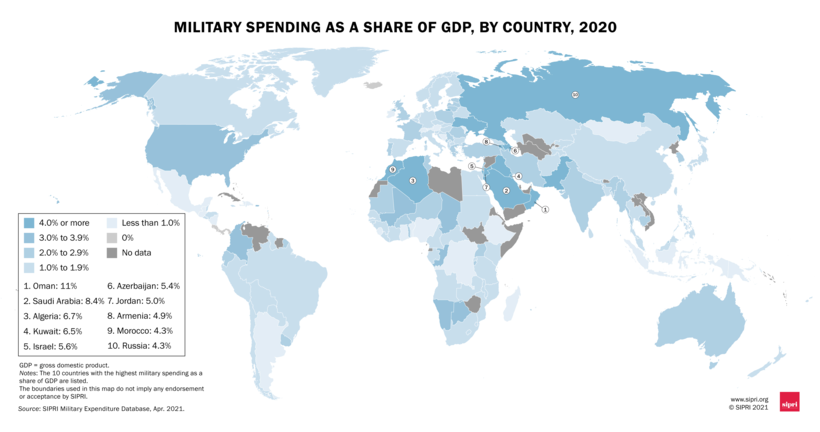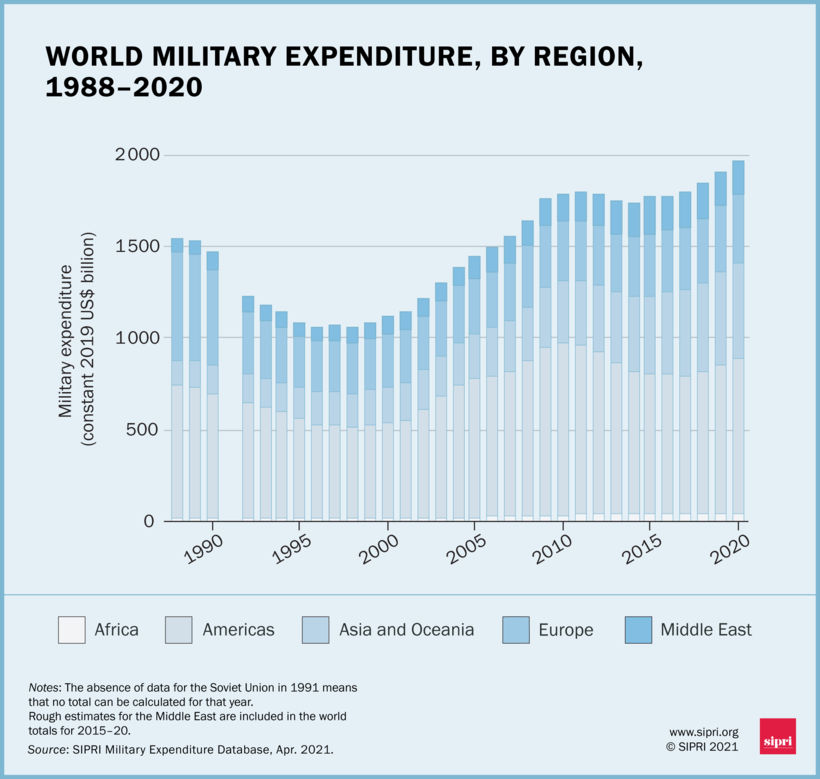For instance, declarations of war between nations and soldier casualties have both dropped drastically since the 20th century. Yet, military spending has not followed this trend.
The Top 10 Military Spenders
According to SIPRI, global military spend reached almost $2 trillion in 2020. The top 10 countries represent roughly 75% of this figure, and have increased their spending by $51 billion since the year prior. Here’s how the worlds top 10 military spenders compare to each other: The U.S. isn’t labeled as a global superpower for nothing. The country is by far the largest military spender, and its $778 billion budget trumps the remainder of the list’s collective $703.6 billion. On its own, the U.S. represents just under 40% of global military spending. This year, Saudi Arabia has lost out on a top five seat to the UK, after a 7.1% decline in spending compared to a 21.5% increase for the UK.
Military Spend as a Percentage of GDP
Military expenditures as a percentage of GDP can be used to compare military spending relative to the size of a country’s economy. Click here to view a high-resolution version of this image. When looking at things this way, many of the top spenders above do not appear. This may be an indication of their economic prowess or a demonstration that the money might be used for other vital areas such as education, healthcare, or infrastructure. It’s pretty rare for countries to reach double digits for military spending as a percentage of GDP. In this case, Oman is an outlier, as the Middle Eastern country’s spending relative to GDP grew from 8.8% last year, to 11% in 2020. Many of the countries with the highest military spending to GDP are located in the Middle East—a reflection of the escalating conflicts that have persisted in the region for well over two decades. It’s worth noting that some data for the Middle Eastern region are estimates, due to the aforementioned regional instability.
More Spending to Come?
Global military spending figures are at a 32-year high, despite the pandemic’s effect on shrinking economic output.
Although a major war hasn’t occurred in some time, it’s not to say the geopolitical mood hasn’t been tense. The last 12 months or so have witnessed some nail-biting moments including:
Border disputes between China and India Heightening tensions between China and Taiwan Russia’s military presence in eastern Ukraine The hacking of SolarWinds, a Texas-based company, by Russia The ongoing Yemen crisis An Israel-Iran feud
Will 2021 extend the trend of peace, or will rising military spending mean even higher tensions? on Even while political regimes across these countries have changed over time, they’ve largely followed a few different types of governance. Today, every country can ultimately be classified into just nine broad forms of government systems. This map by Truman Du uses information from Wikipedia to map the government systems that rule the world today.
Countries By Type of Government
It’s important to note that this map charts government systems according to each country’s legal framework. Many countries have constitutions stating their de jure or legally recognized system of government, but their de facto or realized form of governance may be quite different. Here is a list of the stated government system of UN member states and observers as of January 2023: Let’s take a closer look at some of these systems.
Monarchies
Brought back into the spotlight after the death of Queen Elizabeth II of England in September 2022, this form of government has a single ruler. They carry titles from king and queen to sultan or emperor, and their government systems can be further divided into three modern types: constitutional, semi-constitutional, and absolute. A constitutional monarchy sees the monarch act as head of state within the parameters of a constitution, giving them little to no real power. For example, King Charles III is the head of 15 Commonwealth nations including Canada and Australia. However, each has their own head of government. On the other hand, a semi-constitutional monarchy lets the monarch or ruling royal family retain substantial political powers, as is the case in Jordan and Morocco. However, their monarchs still rule the country according to a democratic constitution and in concert with other institutions. Finally, an absolute monarchy is most like the monarchies of old, where the ruler has full power over governance, with modern examples including Saudi Arabia and Vatican City.
Republics
Unlike monarchies, the people hold the power in a republic government system, directly electing representatives to form government. Again, there are multiple types of modern republic governments: presidential, semi-presidential, and parliamentary. The presidential republic could be considered a direct progression from monarchies. This system has a strong and independent chief executive with extensive powers when it comes to domestic affairs and foreign policy. An example of this is the United States, where the President is both the head of state and the head of government. In a semi-presidential republic, the president is the head of state and has some executive powers that are independent of the legislature. However, the prime minister (or chancellor or equivalent title) is the head of government, responsible to the legislature along with the cabinet. Russia is a classic example of this type of government. The last type of republic system is parliamentary. In this system, the president is a figurehead, while the head of government holds real power and is validated by and accountable to the parliament. This type of system can be seen in Germany, Italy, and India and is akin to constitutional monarchies. It’s also important to point out that some parliamentary republic systems operate slightly differently. For example in South Africa, the president is both the head of state and government, but is elected directly by the legislature. This leaves them (and their ministries) potentially subject to parliamentary confidence.
One-Party State
Many of the systems above involve multiple political parties vying to rule and govern their respective countries. In a one-party state, also called a single-party state or single-party system, only one political party has the right to form government. All other political parties are either outlawed or only allowed limited participation in elections. In this system, a country’s head of state and head of government can be executive or ceremonial but political power is constitutionally linked to a single political movement. China is the most well-known example of this government system, with the General Secretary of the Communist Party of China ruling as the de facto leader since 1989.
Provisional
The final form of government is a provisional government formed as an interim or transitional government. In this system, an emergency governmental body is created to manage political transitions after the collapse of a government, or when a new state is formed. Often these evolve into fully constitutionalized systems, but sometimes they hold power for longer than expected. Some examples of countries that are considered provisional include Libya, Burkina Faso, and Chad.















